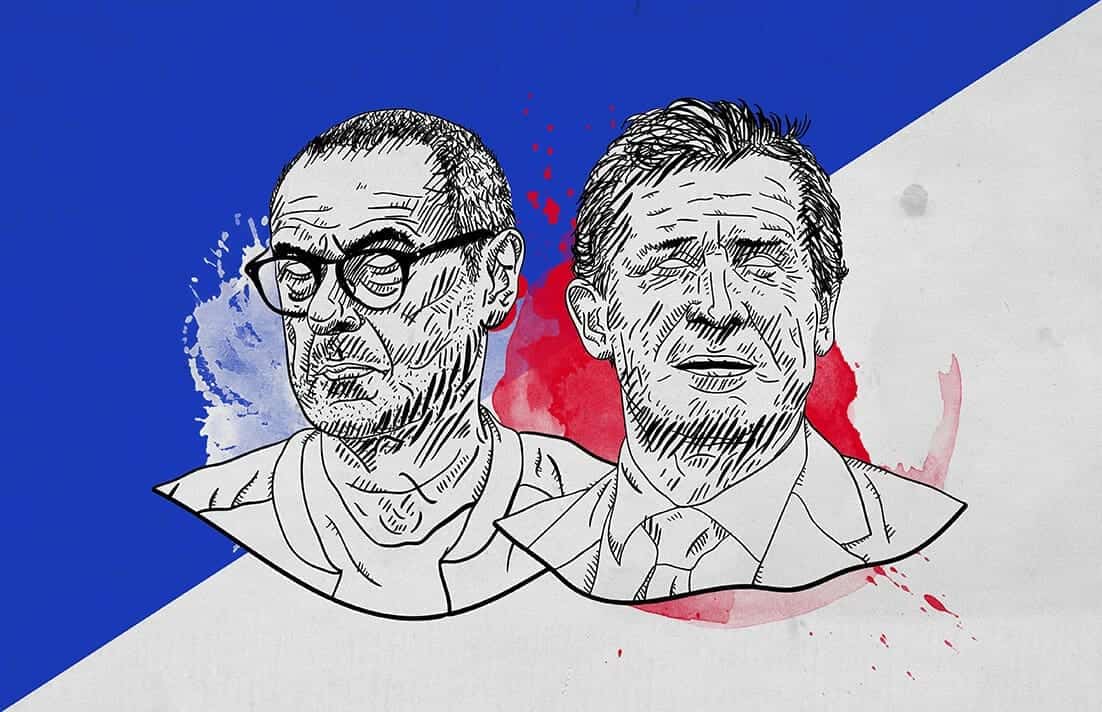This tactical analysis of Southampton vs Chelsea originally featured on our network site feelchelsea.com, a site for all things analysis and Chelsea
Chelsea F.C is proudly back on the map, landing the second rank of the league table after winning over Southampton with a clean sheet. There was a great display of Chelsea’s passing game all over the pitch. However, there is one crucial tactical element added in Chelsea’s deployment of Sarriball which was not so prioritised by Sarri’s men over the last three Premier League fixtures. That tactical strategy followed by the Blues was ‘connecting wing in the build-up’ especially at the left flank which has been ignored in the earlier few league matches. Following tactical analysis reveals how this connection resulted in Chelsea’s coherent passing at the left which in turn caused the coherent passing in the deeper regions due to the wider spaces there.
Chelsea’s offensive patterns on the left flank
In the last two Premier League of clashes of Chelsea against Liverpool and West Ham, the Blues displayed an overly disjointed passing play under the chaotic space-time combinations they were forced to use due to the opponents’ press. As a result, they ended up losing possession earlier than they should have within an offensive action. My last two pieces on the respective Premier League matches explain the same issue which had Sarri men struggled with concluding their attacking runs. In both of the fixtures, they ignored open spaces at the flank which created due to their compressing passing plays at the remaining part of the pitch and rather kept on passing deeply in a sub-optimal scenario of space-time combination.Against Southampton, however, Chelsea were not as ignorant of those open flanks – especially the left flank – as they have been before. The key men who were involved in making the away team stay connected of the left flank during the attacking phase were Hazard and Alonso. Hazard stayed more at the wings than in the earlier aforementioned fixtures, which along with Alonso’s presence already there kept the Blues connected to the left width.

In the following pictures, Hazard and Alonso stretched to the width which not only enabled them to create the attack from the wide but also stretched the opponent defence enough to create a huge space in the centre which the central midfielders would effectively utilise.


The overlapping of the winger and the full-back on different occasions, as well as the coherent passing between the two and among the other inside teammates, allowed the two wide players to stretch the game via their both on-and-off-the-ball moves. This also made Chelsea’s other teammates to utilise the left flank in both attacking and transitional phases. In the previous fixtures, however, Chelsea couldn’t enjoy creating such gaps in the centre due to their consistent ignorance and dissociation with the left flank where the full-back remains all ready to make a progressive run.

More coherency than before
As a result of the greater focus on keeping the left flank connected with the build-up, Chelsea’s offensive display at the left flank was more coherent than in the last two Premier League fixtures. Due to this coherency at the left width, Chelsea were able to stretch the opposing defence. This created spaces in the region of Chelsea’s final third to be exploited by the central midfielders as illustrated above. That empty space in the central region was not only to be used by the central midfielders but also by Hazard who would later make run there to form quick touch and pass patterns with the teammates in the final third.As already shown above, there was a clear availability of spaces in the deep, due to Hazard’s and Alonso’s passing display and off-the-ball moves at the width. The utilisation of these spaces to create some essential attacking opportunities via short passes led to obvious coherency in the passing patterns of Chelsea’s advanced players which was not so prevalent in the earlier four halves played. In other words, Chelsea’s passing coherency at the left flank resulted in its passing coherency at the deeper regions, too.Chelsea’s passing coherency in the recent fixture also resulted in the greater accuracy of the passes played to the final third. Chelsea played 87 per cent of accurate passes to the final third out of the total passes played to the region, while on average the team has had the accuracy of 83 per cent for the passes played to the final third since the start of the current Premier League season. Besides, the total smart passes played in the fixture, i.e. 14, were also greater than Chelsea’s current season average of 8.5, with an accuracy of 64 per cent which is also much greater than the Blues’ mean smart pass accuracy of 42.7 per cent.In the following passing maps of Chelsea’s recent three Premier League fixtures including the one against the Saints (top plane), there can be seen a strong cross-connection among Alonso (3), Jorginho (5), Luiz (30), and Hazard (10) in the Southampton fixture compared to the connection among the same group in the earlier fixtures. Not only this, but there is also a more coherent link among the advanced players in the passing map against Southampton than the link in the other fixtures (bottom plane).

Conclusion
Summing up the tale, the passing coherency by the Blues in the advanced deeper regions allowed the away team to make optimal use of space-time combination, something which Chelsea’s frontline was unable to do ever since the opponents have realised to press Jorginho in order to disturb Chelsea’s build-up around him.





Comments